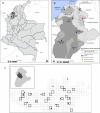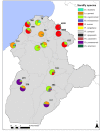Diversity patterns, Leishmania DNA detection, and bloodmeal identification of Phlebotominae sand flies in villages in northern Colombia
- PMID: 29320544
- PMCID: PMC5761875
- DOI: 10.1371/journal.pone.0190686
Diversity patterns, Leishmania DNA detection, and bloodmeal identification of Phlebotominae sand flies in villages in northern Colombia
Abstract
Leishmaniases are neglected tropical diseases exhibiting complex transmission cycles due to the number of parasite species circulating, sand fly species acting as vectors and infected mammals, including humans, which are defined in the New World as accidental hosts. However, current transmission scenarios are changing, and the disease is no longer exclusively related to forested areas but urban transmission foci occur, involving some species of domestic animals as suspected reservoirs. The aim of this study was to determine the transmission cycles in urban environments by evaluating sand fly diversity, detection of Leishmania DNA, and bloodmeal sources through intra and peridomestic collections. The study was carried out in Colombia, in 13 municipalities of Cordoba department, implementing a methodology that could be further used for the evaluation of vector-borne diseases in villages or towns. Our sampling design included 24 houses randomly selected in each of 15 villages distributed in 13 municipalities, which were sampled in two seasons in 2015 and 2016. Sand flies were collected using CDC light traps placed in intra and peridomestic habitats. In addition to the morphological identification, molecular identification through DNA barcodes was also performed. A total of 19,743 sand flies were collected and 13,848 of them (10,268 females and 3,580 males) were used in molecular procedures. Circulation of two known parasite species-Leishmania infantum and Leishmania panamensis was confirmed. Blood source analyses showed that sand flies fed on humans, particularly in the case of the known L. infantum vector, P. evansi; further analyses are advised to evaluate the reservoirs involved in parasite transmission. Our sampling design allowed us to evaluate potential transmission cycles on a department scale, by defining suspected vector species, parasite species present in different municipalities and feeding habits.
Conflict of interest statement
Figures



Similar articles
-
Measuring spatial co-occurrences of species potentially involved in Leishmania transmission cycles through a predictive and fieldwork approach.Sci Rep. 2021 Mar 24;11(1):6789. doi: 10.1038/s41598-021-85763-9. Sci Rep. 2021. PMID: 33762622 Free PMC article.
-
Leishmania spp. Infection Rate and Feeding Patterns of Sand Flies (Diptera: Psychodidae) from a Hyperendemic Cutaneous Leishmaniasis Community in Panamá.Am J Trop Med Hyg. 2019 Apr;100(4):798-807. doi: 10.4269/ajtmh.17-0628. Am J Trop Med Hyg. 2019. PMID: 30793681 Free PMC article.
-
Ecology, feeding and natural infection by Leishmania spp. of phlebotomine sand flies in an area of high incidence of American tegumentary leishmaniasis in the municipality of Rio Branco, Acre, Brazil.Parasit Vectors. 2018 Jan 26;11(1):64. doi: 10.1186/s13071-018-2641-y. Parasit Vectors. 2018. PMID: 29373995 Free PMC article.
-
Can Sergentomyia (Diptera, Psychodidae) play a role in the transmission of mammal-infecting Leishmania?Parasite. 2016;23:55. doi: 10.1051/parasite/2016062. Epub 2016 Dec 6. Parasite. 2016. PMID: 27921993 Free PMC article. Review.
-
Incriminating leishmaniases vectors in Colombia: An overview and roadmap for future research.Acta Trop. 2024 Dec;260:107409. doi: 10.1016/j.actatropica.2024.107409. Epub 2024 Sep 22. Acta Trop. 2024. PMID: 39317308 Review.
Cited by
-
An overview of the trypanosomatid (Kinetoplastida: Trypanosomatidae) parasites infecting several mammal species in Colombia.Parasit Vectors. 2022 Dec 16;15(1):471. doi: 10.1186/s13071-022-05595-y. Parasit Vectors. 2022. PMID: 36522757 Free PMC article.
-
Behavioral Aspects of Phlebotomine Sand Flies Associated with a Case of Cutaneous Leishmaniasis in Atlántico, Northern Colombia.Am J Trop Med Hyg. 2020 Apr;102(4):768-776. doi: 10.4269/ajtmh.19-0245. Am J Trop Med Hyg. 2020. PMID: 32043444 Free PMC article.
-
Complex ecological interactions across a focus of cutaneous leishmaniasis in Eastern Colombia: novel description of Leishmania species, hosts and phlebotomine fauna.R Soc Open Sci. 2020 Jul 8;7(7):200266. doi: 10.1098/rsos.200266. eCollection 2020 Jul. R Soc Open Sci. 2020. PMID: 32874625 Free PMC article.
-
Pathogens, reservoirs, and vectors involved in the transmission of vector-borne and zoonotic diseases in a Colombian region.Braz J Microbiol. 2023 Jun;54(2):1145-1156. doi: 10.1007/s42770-023-00903-9. Epub 2023 Feb 25. Braz J Microbiol. 2023. PMID: 36828985 Free PMC article.
-
Evaluating the spatial distribution of Leishmania parasites in Colombia from clinical samples and human isolates (1999 to 2016).PLoS One. 2019 Mar 27;14(3):e0214124. doi: 10.1371/journal.pone.0214124. eCollection 2019. PLoS One. 2019. PMID: 30917177 Free PMC article.
References
-
- World Health Organization. Fact sheet. Updated April 2017. Available from http://www.who.int/mediacentre/factsheets/fs375/en/. Cited 14 September 2017.
-
- Velez ID, Hendrickx E, Robledo SM, Agudelo S del P. Leishmaniosis cutánea en Colombia y género. Cad Saude Publica. 2001;17(1):171–80. - PubMed
-
- González M, Benito F, García L, Iglesias A. Mucocutaneous leishmaniasis: an imported illness with ENT repercussions. Acta Otorrinolaringol española. 2009;60(4):298–300. - PubMed
-
- González C, Paz A, Ferro C. Predicted altitudinal shifts and reduced spatial distribution of Leishmania infantum vector species under climate change scenarios in Colombia. Acta Trop [Internet]. 2014. January [cited 2014 Sep 28];129:83–90. doi: 10.1016/j.actatropica.2013.08.014 - DOI - PubMed
Publication types
MeSH terms
Substances
LinkOut - more resources
Full Text Sources
Other Literature Sources

